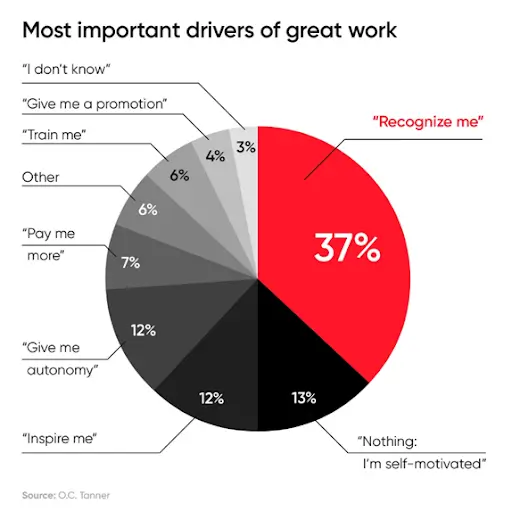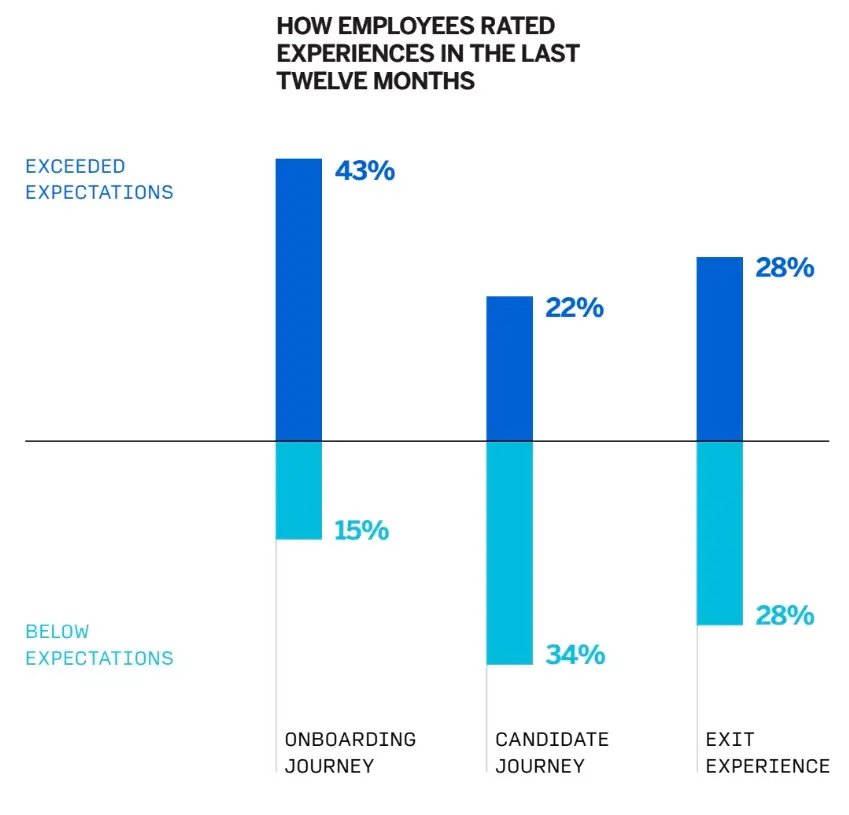In today’s agile, disrupted business world, organizations are lucky to hold onto their employees for more than four years.
The latest statistic (January 2024) from the Bureau for Labor Statistics finds that the median number of years that wage and salary workers had been with their current employer was 3.9 years, down from 4.1 years in January 2022.
In that 3.9 years, an employee has probably received a year of onboarding and ramp time, three years of training and development, perhaps one promotion… and then they leave. All that investment, just to have your employee walk out of the door.
Free eBook: 2025 Global Employee Experience Trends Report
What is employee loyalty?
A definition of employee loyalty is: how much employees are committed, emotionally attached and involved with their organization.
The more loyal the employee, the less likely they are to criticize their employer publicly, keep a lookout for other jobs, or leave. They are engaged and tend to work hard, with enthusiasm and creativity.
What is the connection between loyalty and engagement?
There’s a strong correlation between employee loyalty and employee engagement. When employees are highly engaged at work, generally they tend to stay for longer as they are learning, developing, participating, and applying their learned skills confidently.
The benefits of fostering employee loyalty
Cost reduction
As we’ve seen from the introductory stat, employees who stay longer reduce your recruitment rate and save recruitment costs.
Increased productivity
Employees who are both loyal and engaged care about their organization; they know that if it performs well, they will benefit. Not just financially, but in terms of job security and career development prospects too, which inspires employees to work productively.
A positive work culture
Employees who enjoy coming to work, are treated well and trust other team members make the company culture a positive one. When a company culture is positive, it draws in satisfied customers and enhances the brand reputation – more good people want to come and work there, and more people want to buy the goods and services.
Resilience through challenges
Nobody knows what’s around the next corner, organizationally, economically, or globally. Black swan events can come seemingly out of nowhere. This is where loyal employees really come into their own, many sticking with the organization and giving their all to get through tough times.
Factors that influence employee loyalty
Our 2025 EX Trends Report found something fascinating – and surprising – that has ramifications for influencing employee loyalty, which is why this is top of our list:
1. Being listened to
With rapid change and disruption becoming the norm, it’s never been more important to listen to and understand the needs of your employees, whether they’re struggling with processes, or becoming disengaged.
By listening to your employees, you’ll be able to streamline troublesome processes, supply the right tools and tech, remove unnecessary red tape, and empower employees to be autonomous.
2. Fair pay and benefits
Reward employees. No effective employee is going to give their all or stick around if they are poorly compensated.
3. Opportunities for employee development
Similarly, organizations benefit from training and developing their people.
Richard Branson sums it up perfectly:
Train people well enough so they can leave, treat them well enough so they don’t want to.
4. Recognition and appreciation
A study by Greatplacetowork.com found that “Recognize me” is the most important driver of doing great work that can improve employee loyalty.

Image source: https://www.greatplacetowork.com/resources/blog/creating-a-culture-of-recognition
Learn more about employee recognition
5. Trust between employees, management and leadership
Trust is a hard-won, but powerful thing. Get it right and employees remain loyal.
Trust is the magic glue that makes personal and professional relationships thrive. When we trust each other, everything becomes possible.
– Aron Ain, formerly Chairman and CEO of UKG.
We include ensuring work life balance in this as a trust thing too. Managers and leaders need to trust employees to work flexibly and remotely so they can balance job and work to avoid burnout.
Challenges to employee loyalty
Employee loyalty doesn’t just magically happen, it’s a combination of factors. For example, excellent pay and benefits won’t create a loyal employee if the company culture is one of bullying and suspicion.
Our trends report uncovered some more fascinating challenges:
1. Young employees
We found that employees aged under 25 are the most engaged and positive of all the employee groups. This goes against media narratives that young employees are quiet quitters, lacking work ethic and commitment. Not only are they enthusiastic, they’re also keener than any other age group to bring value to their organizations, and are incredibly optimistic about their future.

BUT your enthusiastic, keen, under-25 employees also have a lot of pressures: the cost of education, cost of living, mental health, new ways of working, and plans for training and career growth. These factors often make them unable to commit to one employer for an extended period of time. How are you going to keep them?
2. Chaotic working practices
Employees have been forced to adapt to change and uncertainty again and again over the past few years. But while loyal employees have gone above and beyond to meet ever-increasing expectations of management, the organizational systems and processes have lagged behind, making work feel harder and more complex than ever for them.
This constant chaos is putting pressure on employees to increase productivity, with 38% feeling pressure. This affects their intent to stay.
The more demands that are placed on loyal employees, the more likely they are to leave. How can you find out what they need so you can keep them?
3. Employee experiences are being tainted by entry and exit
In 2024 we highlighted that onboarding practices had been allowed to slip. In 2025, we found that the candidate experience for new hires had slipped even below onboarding, with the exit experience only a little better:

Getting these first and last experiences right is important because they influence the relationship between organization and employee. Bad first impressions can put off a potential loyal employee.
And when exit experiences are neglected, organizations miss out on vital data that explains the reasons why people leave or stay, even alienating potential brand advocates. How can you engage your people right from the start?
4. Short term financial gains cost long term human trust
Because the business world is more volatile and uncertain, employee trust is more important than ever. It informs how employees will interact with each other, with technology and with organizations.
We found that employees tend to trust their leaders’ competence and integrity, with a 63% favorability rating across the globe. Yet, only 56% of employees feel leaders will be benevolent, i.e. choosing employee wellbeing over immediate profit or gain. Loyal employees need to feel they’re more than just a number in a money-generating machine. How can you reassure them?
Building employee loyalty
When people are financially invested, they want a return. When people are emotionally invested, they want to contribute.
– Simon Sinek
Support young people
Firstly, you need an understanding of what your young employees want. We discovered their most important requirements are:
- Meeting their career aspirations in meaningful career path development discussions with management
- Employee benefits that meet their needs
- Management behavior that chimes with belief in company values
It’s important that you show younger workers that you truly care about them, which you can do by including them right from the beginning in discussions and feedback.
How technology can help understand younger employees
Use tools that uncover attrition factors in different segments of your workforce so you can pinpoint why your younger employees leave. Employee journey analytics are really important here so you can identify areas of weakness (such as onboarding) that may have been negative experiences.
Reduce chaos for employees
People are adaptable, but ask them to be so too often, and they’ll walk. Eliminate poor experiences and streamline work by:
- Simplifying processes to help employees meet customer needs
- Improving how work gets done
- Developing innovative ways to serve customers
It has never been more important to listen to and understand the needs of your people, whether they’re struggling with processes, or disengaged. Traditional employee listening, such as the distracting annual and quarterly survey, are no longer enough. Instead, consider multiple methods of understanding what your people want and need, without interrupting their working day.
How technology can help reduce chaos
Tap into how your employees are feeling with active listening: engagement solutions and frequent pulsing.
Or, as 59% of surveyed employees are comfortable with passive listening, tap into the data employees effortlessly generate as part of their day-to-day activities (e.g. work emails, communication channels)
Improve entry and exit experiences
To stand the best chance of keeping loyal employees, it pays to make a great first impression with their candidate and onboarding experience. And when you have to part company with even your most loyal employee (who you hope will be a brand ambassador) it’s important to know the reason they are leaving.
How technology can help with first days and last days
Identify experience gaps along an employee’s journey with employee onboarding and exit experience tools that will swiftly tell you if your entry/exit strategies are fit for purpose. Use employee retention analytics to discover why some people go and some stay.
Build trust
Trust and loyalty go hand in hand. And when people trust their organization, they:
- Are proactive and self-starting
- Take information on board
- Are willing to change behavior
- Forgive errors and misjudgments
- Are willing to advocate without being asked
Most employees believe their leaders are competent and aligned with the organization’s values, but only 56% feel they are benevolent – likely to put an employee before a financial gain.
To reassure employees, managers need to be open to diverse perspectives that challenge, contrast with, or differ from their own, and be courageous enough to take them on board.
How technology can help build trust
Managers can garner opinions quickly with pulse surveys, or see the bigger picture with an experience data platform.
How Qualtrics can help build employee loyalty
Using our tools, you’ll be able to get a complete picture of your entire employee experience, helping you to implement all the right employee retention strategies and keeping your great people loyal.
With XM for Employee Experience, you have everything you need to build engaged, high-performance teams, improve manager trust and individual effectiveness, and make timely business decisions that ensure impact and success.



